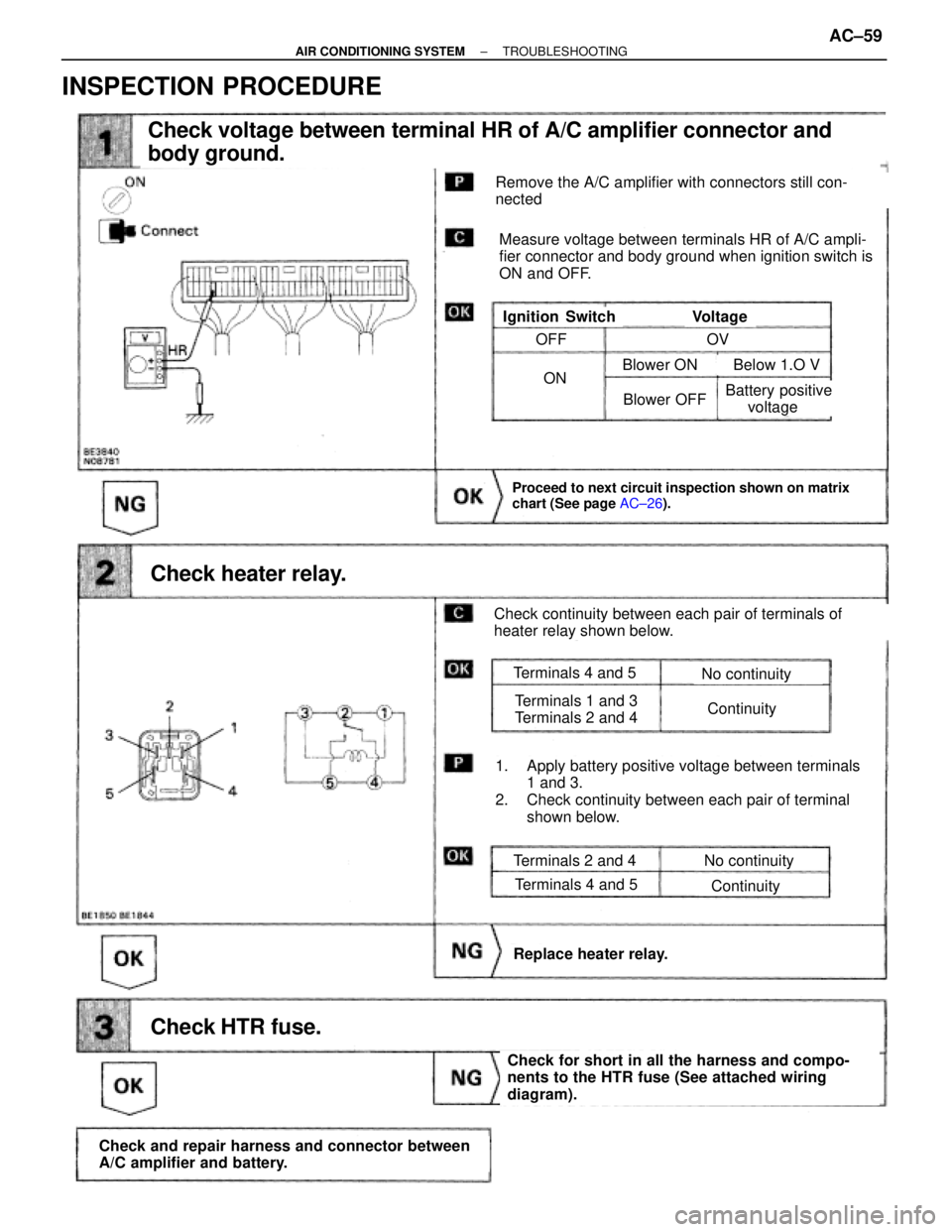Page 18 of 2543

INDICATOR CHECK
1. Turn the ignition switch on while pressing the air conditioning
control AUTO switch and R/F SW simultaneously.
2. Check that all the indicators light up and go off at 1
second intervals 4 times in succession.
HINT:
wAfter the indicator check is ended, the diagnostic sensor
check begins automatically.
wPress the OFF switch when cancelling the check mode.
DIAGNOSTIC SENSOR CHECK
1. Perform an indicator check. After the indicator check is
completed, the system enters the diagnostic sensor check
mode automatically.
2. Check the LED blinking on the panel. Refer to the list of codes
on page AC±20 when translating the trouble code from the
LED blinking.
If the slower display is desired, press the RDEF switch and
change it to step operation. Each time the RDEF switch is
pressed, the blinking LED changes by 1 step.
CLEARING TROUBLE CODES' MEMORY
Method 1:
1. Pull out the ECU±B fuse in Junction Block No. 1 for 10 sec.
or longer to clear the trouble codes' memory.
2. After reinserting the fuse, check that the normal code is
output.
Method 2:
Press the RDEF switch while pushing the A/C switch during
the sensor check mode. AC±18
± AIR CONDITIONING SYSTEMTROUBLESHOOTING
Page 53 of 2543
INSPECTION PROCEDURE
Remove the A/C amplifier with connector still con-
ected.
Measure voltage between terminal + B of air condi-
tioner control assembly connector and body ground.
Voltage: Battery positive voltage
Proceed to next circuit inspection shown on matrix
chart (See page AC±26).
Remove ECU±B fuse from J/B No. 1.
Check continuity of ECU±B fuse.
Continuity
Check ECU±B fuse.
Check for short in all the harness and compo-
nents to the ECU±B fuse (See attached wiring
diagram).
Check voltage between terminal +B of A/C amplifier connector and
body ground.
Check and repair harness and connector between
A/C amplifier and battery.
± AIR CONDITIONING SYSTEMTROUBLESHOOTINGAC±53
Page 55 of 2543
Check continuity between terminal GND of A/C amplifier and body
ground.
Measure resistance between terminal GND of A/C
amplifier and body ground.
Remove HTR fuse from J/B No. 1.
Check continuity of HTR fuse.
Continuity
Check for short in all the harness and compo-
nents to the HTR fuse (See attached wiring
diagram).
Check and repair harness and connector between
A/C amplifier and battery.
Check HTR fuse.
Repair or replace harness or connector.
Resistance: O �� �continuity)
± AIR CONDITIONING SYSTEMTROUBLESHOOTINGAC±55
Page 57 of 2543
INSPECTION PROCEDURE
Check voltage between terminal ACC of A/C amplifier connector and
body ground.
Remove the A/C amplifier with connector still connected
Voltage: Battery positive voltage
1. Turn ignition switch To ACC.
2. Measure voltage between terminals ACC of A/C
amplifier connector and body ground.
Remove CIG fuse from J/B No. 1.
Check continuity of CIG fuse.
Continuity
Proceed to next circuit inspection shown on matrix
chart (See page AC±26).
Check CIG fuse.
Check for short in all the harness and compo-
nents to the CIG fuse (See attached wiring
diagram).
Check and repair harness and connector between
A/C amplifier and battery.
± AIR CONDITIONING SYSTEMTROUBLESHOOTINGAC±57
Page 59 of 2543

Check voltage between terminal HR of A/C amplifier connector and
body ground.
Check heater relay.
Proceed to next circuit inspection shown on matrix
chart (See page AC±26).
Check HTR fuse.
Check and repair harness and connector between
A/C amplifier and battery.
Check for short in all the harness and compo-
nents to the HTR fuse (See attached wiring
diagram).
Replace heater relay.
Remove the A/C amplifier with connectors still con-
nected
Measure voltage between terminals HR of A/C ampli-
fier connector and body ground when ignition switch is
ON and OFF.
VoltageIgnition Switch
Check continuity between each pair of terminals of
heater relay shown below.
1. Apply battery positive voltage between terminals
1 and 3.
2. Check continuity between each pair of terminal
shown below.
Terminals 2 and 4
Terminals 4 and 5
No continuity
Continuity
Terminals 4 and 5
Terminals 1 and 3
Terminals 2 and 4
No continuity
Continuity
OFF
ON
OV
Blower OFF
Blower ON Below 1.O V
Battery positive
voltage
INSPECTION PROCEDURE
± AIR CONDITIONING SYSTEMTROUBLESHOOTINGAC±59
Page 116 of 2543

INTRODUCTIONGENERAL REPAIR INSTRUCTIONS -
IN-5
the specified seal lock adhesive to the bolt, nut or
threads.
(c) Precoated parts are indicated in the component il-
lustrations by the º�º symbol.
7. When necessary, use a sealer on gaskets to prevent
leaks.
8. Carefully observe all specifications for bolt tightening
torques. Always use a torque wrench.
9. Use of special service tools (SST) and special service ma-
terials (SSM) may be required, depending on the nature
of the repair. Be sure to use SST and SSM where speci-
fied and follow the proper work procedure. A list of SST
and SSM can be found at the preparation of AT section.
10. When replacing fuses, be sure the new fuse has the cor-
rect amperage rating. DO NOT exceed the rating or use
one with a lower rating.
11. To pull apart electrical connectors, pull on the connector
itself, not the wires.
12. Care must be taken when jacking up and supporting the
vehicle. Be sure to lift and support the vehicle at the prop-
er locations.
(a) If the vehicle is to be jacked up only at the front or
rear end, be sure to block the wheels at the opposite
end in order to ensure safety.
(b) After the vehicle is jacked up, be sure to support it on
stands. It is extremely dangerous to do any work on
a vehicle raised on a jack alone, even for a small job
that can be finished quickly.
Page 421 of 2543

The trouble code is indicated, as shown in the illustration at
left (Diagnostic trouble code º42º is
shown as an example).
HINT: When 2 or more trouble codes are stored in memory,
the lower±numbered code is displayed first. If no diagnostic
trouble code is output, or if a diagnostic trouble code is output
even though no diagnostic trouble code output operation is
performed, check the TE 1 terminal circuit on page AT1±93.
DIAGNOSTIC TROUBLE CODE CHECK
BY USING TOYOTA HAND±HELD
TESTER
1. Hook up the TOYOTA hand±held tester to the DLC2.
2. Read the diagnostic trouble codes by following the prompts
on the tester screen.
Please refer to the TOYOTA hand±held tester operator's
manual for further details.
CANCELING DIAGNOSTIC TROUBLE
CODE
After repair of the trouble area, the diagnostic trouble code
retained in the ECM memory must be canceled out by remov-
ing the EFI fuse for 10 seconds or more, with the ignition
switch OFF.
Check that the normal code is output after connecting the
fuse.
ECM TERMINALS STANDARD VALUE
ECM TERMINAL VALUES
MEASUREMENT BY USING TOYOTA BREAK±OUT ±BOX
AND TOYOTA HAND±HELD TESTER
1. Hook up the TOYOTA break±out±box and TOYOTA
hand±held tester to the vehicle.
2. Read the ECM input/output values by following the prompts
on the tester screen.
HINT: TOYOTA hand±held tester has a ºSnapshotº function.
This records the measured values and is effective in the diag-
nosis of intermittent problems.
Please refer to the TOYOTA hand±held tester / TOYOTA
break±out box operator's manual for further details.
± AT340E (2JZ±GE) AUTOMATIC TRANSMISSIONTROUBLESHOOTINGAT1±35
Page 519 of 2543

The trouble code is indicated as shown in the illustration at
left (Diagnostic trouble code º42º is shown as an example).
HINT: When 2 or more trouble codes are stored in memory,
the lower±numbered code is displayed first.
If no diagnostic trouble code is output, or if a diagnostic
trouble code is output even though no diagnostic trouble
code output operation is performed, check the TE1 terminal
circuit on page AT2±113
ECM DATA MONITOR USING TOYOTA
HAND±HELD TESTER
1. Hook up the TOYOTA hand±held tester to the DLC2.
2. Monitor the ECM data by following the prompts on the tester
screen.
HINT: TOYOTA hand±held tester has a ºSnapshotº function
which records the monitored data.
Please refer to the TOYOTA hand±held tester operator's
manual.
CANCELING DIAGNOSTIC TROUBLE
CODE
After repair of the trouble area, the diagnostic trouble code
retained in the ECM memory must be canceled out by remov-
ing the EFI No.1 fuse for 10 seconds or more, with the ignition
switch OFF.
Check that the normal code is output after connecting the
fuse.
ECM TERMINALS STANDARD VALUE
ECM TERMINAL VALUES
MEASUREMENT BY USING TOYOTA BREAK±OUT ±BOX
AND TOYOTA HAND±HELD TESTER
1. Hook up the TOYOTA break±out±box and TOYOTA
hand±held tester to the vehicle.
2. Read the ECM input/output values by following the prompts
on the tester screen.
HINT: TOYOTA hand±held tester has ºSnapshotº function.
This record the measured values and is effective in the diag-
nosis of intermittent problems.
Please refer to the TOYOTA hand±held tester/ TOYOTA
break±out±box operator's manual for further details.
± A340E (2JZÐGTE) AUTOMATIC TRANSMISSIONTROUBLESHOOTINGAT2±35